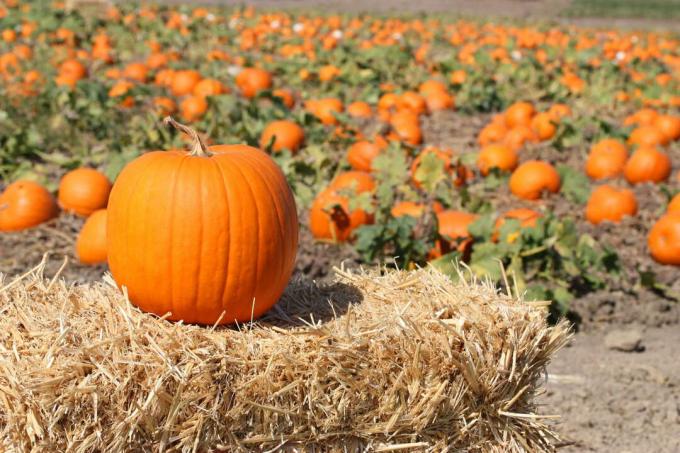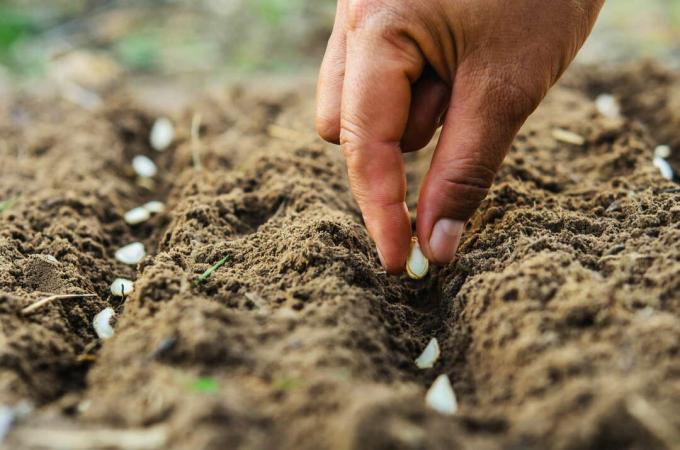Here are 10 practical tips on how you can grow pumpkins easily and cheaply in your own garden.

Belong to autumn and Halloween pumpkins easy to. Whether as jack o lantern with a cheeky face, a decorative garden element or as a delicious soup: pumpkins sweeten autumn for us. Nevertheless, the versatile vegetable is not grown in too many gardens. There are only a few simple tricks to follow and pumpkins will feel right at home in your garden.
contents
- 10. Pumpkin Variety Choice
- 9. location for pumpkins
- 8. The right soil for the pumpkin
- 7. Sowing and planting out
- 6. Water the pumpkins properly
- 5. Fertilize pumpkins
- 4. quality not quantity
- 3. Up with the pumpkins
- 2. timing of the pumpkin harvest
- 1. Store pumpkins properly
If you've gotten the pumpkin flavor now, then by all means read on. We show you how you can easily grow pumpkins that will make others green with envy.
10. Pumpkin Variety Choice
When it comes to pumpkins, you are spoiled for choice: from unusual patterns and colors to giants in the vegetable patch: there is the right one for everyone
pumpkin variety included. Therefore, you should think in advance what should enrich the home garden. Do you prefer something decorative or tasty and hearty for the kitchen? When buying, however, make sure whether the pumpkins are ornamental or edible. Ornamental gourds possess the Bitter substance cucurbitacin, which not only makes them unbearably bitter, but above all highly toxic.
9. location for pumpkins
The selection of a suitable area should also be well thought out. After all, pumpkins are not one of those vegetables that find a place everywhere; on the contrary, a pumpkin plant needs a lot of space: the plant should definitely be given 1.5 to 2 square meters. The plant also likes it sunny and warm. Six hours of sunlight a day is a must for the plant to grow tall and orange. However, care should be taken with neighboring beds: ornamental gourds and edible gourds should never be close together – they could otherwise pollinate each other and before you know it, the delicious squashes also contain the toxic bitter substances. Also other pumpkin plant like that zucchini are neither ideal pre-plants nor good border neighbors.

8. The right soil for the pumpkin
In addition to sun and space, the pumpkin also needs good soil. The plant prefers light to medium-sandy soils with a high humus content. In order to obtain such soil, it is advisable to thoroughly dig up the bed a week before planting and mix it with a good portion of compost. This not only promotes the soil structure, but also provides the pumpkin with important nutrients. A little tip: Right next to the compost heap, the pumpkins not only get an extra portion of nutrients - they also cover up the unsightly stains with their tendrils in a decorative way. Of course you can also use a pre-fertilized vegetable soil like our peat-free Plantura organic tomato & vegetable soil use for growing pumpkins.
7. Sowing and planting out
When everything is prepared and planned, you can start sowing. Even if the pumpkin is otherwise very robust: Unfortunately, the plant does not tolerate cold. You should therefore definitely wait for the ice saints and the last night frosts. Even temperatures above 14°C are ideal for germination. If you don't want to wait that long, you can bring the pumpkins indoors from the end of April. One seed per pot is enough; when the first leaflets appear and the ice saints are over, these plants can also make their way into the bed.

6. Water the pumpkins properly
The pumpkin has one thing above all: thirst. In order to form large fruits, the plant needs a lot of water and should be watered regularly. But be careful: fungal diseases only like to see water on the leaves and fruits. To keep the plant healthy, you should only water directly at the ground. The plant also does not tolerate waterlogging well. A little tip for a homemade “watering system”: dig a traditional clay flower pot halfway into the ground next to the pumpkin. Instead of watering the pumpkin, put the water in the pot instead - this way it gets to the roots faster and waterlogging and damp leaves are avoided.

5. Fertilize pumpkins
If you want to grow big and strong, you need enough food - this also applies to pumpkins. Compost should be mixed into the soil before sowing to ensure the perfect start in life. But even after that, the pumpkin won't say no to a portion of fertilizer. Above all, organic fertilizers such as compost or ours are suitable for this Plantura organic tomato fertilizer with long-term effect. It is also important to pay attention to the nitrogen balance: the more nitrogen the plant has available, the larger the fruit it will ultimately produce.
4. quality not quantity
A real flower more on your pumpkins? It may look nice, but it doesn't always serve the purpose: If a pumpkin bears too many fruits, it is quickly overwhelmed and all the pumpkins remain small and puny. Therefore, thin out early and remove all but two or three female flowers from the plant. These differ from the male flowers by short stems and a thickening below the petals. Since pumpkins are dependent on cross-pollination, the fruit set can be very sparse, especially if there is a lack of insects. If you don't feel like it, you can rely on manual work: You can easily pollinate the stigma of the female flower with the stamen of the male flower.

3. Up with the pumpkins
This tip may sound strange at first, after all, most types of pumpkin grow on the ground. But if you take a closer look, you quickly realize why it can be useful to lift the pumpkins a little. Especially in rainy summers, the orange fruits otherwise lie permanently on the damp ground. The consequences range from rotten spots to fungal diseases to total failure. In the case of small pumpkin species, it is worth having a Pumpkin trellis set up where the plants stretch themselves up into the sky. In the case of large and only weakly climbing varieties, it is advisable to place the fruit on a base (e.g. a flat, inverted clay bowl). In this way, the fruits are at least protected from soil moisture.

2. timing of the pumpkin harvest
Pumpkins are a typical fall vegetable. No wonder, then, that they need until autumn to fully mature. A good indication of the right time to harvest pumpkins is the condition of the leaves. Once these start to dry, it's time for the pumpkin to leave its home. With some varieties, the fruit can also be recognized by the typical hollow sound when you tap the skin with your fist. Use a sharp knife to harvest. Be sure to leave a piece of the stalk on the squash: not only does it look better, but it also helps the squash last longer.

1. Store pumpkins properly
There is already an army of funny pumpkin candles in front of the door and the pumpkin soup doesn't taste as good as it did at the beginning? No problem, after all you can store the pumpkin without any problems. It is best to leave the pumpkin in the sun for a few days after harvest so that the skin can harden a little. The orange fruits can then be stored in a cool, dry room for several months. Only the bad fruit should be sorted out regularly so that the rot does not spread to other pumpkins.

How your Harvest and store pumpkins properly, you can read more about it in our special article.



